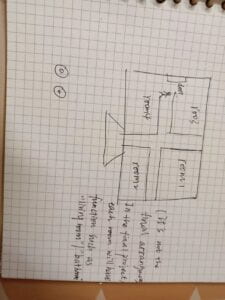Part 1: Media controller
Code
Arduino
// IMA NYU Shanghai
// Interaction Lab
// For sending multiple values from Arduino to Processing
void setup() {
Serial.begin(9600);
}
void loop() {
// to send values to Processing assign the values you want to send
//this is an example
int sensor1 = analogRead(A0);
// int sensor2 = analogRead(A1);
// int sensor3 = analogRead(A2);
// send the values keeping this format
Serial.print(sensor1);
// Serial.print(","); // put comma between sensor values
// Serial.print(sensor2);
// Serial.print(","); // put comma between sensor values
// Serial.print(sensor3);
Serial.println(); // add linefeed after sending the last sensor value
// too fast communication might cause some latency in Processing
// this delay resolves the issue.
delay(100);
// end of example sending values
}
Processing
// IMA NYU Shanghai
// Interaction Lab
// For receiving multiple values from Arduino to Processing
/*
* Based on the readStringUntil() example by Tom Igoe
* https://processing.org/reference/libraries/serial/Serial_readStringUntil_.html
*/
import processing.serial.*;
import processing.video.*;
int NUM_OF_VALUES_FROM_ARDUINO = 1; /** YOU MUST CHANGE THIS ACCORDING TO YOUR PROJECT **/
int sensorValues[]; /** this array stores values from Arduino **/
String myString = null;
Serial myPort;
Movie myMovie;
void setup() {
size(1280, 720);
myMovie = new Movie(this, "shuimu.mp4");
myMovie.play();
setupSerial();
}
void draw() {
getSerialData();
printArray(sensorValues);
if (myMovie.available()) {
myMovie.read();
}
float m = map(sensorValues[0], 0, 1023, 0, 255);
tint(m, 255, 255);
image(myMovie, 0, 0);
}
// use the values like this!
// sensorValues[0]
// add your code
//
void setupSerial() {
printArray(Serial.list());
myPort = new Serial(this, Serial.list()[ 2 ], 9600);
// WARNING!
// You will definitely get an error here.
// Change the PORT_INDEX to 0 and try running it again.
// And then, check the list of the ports,
// find the port "/dev/cu.usbmodem----" or "/dev/tty.usbmodem----"
// and replace PORT_INDEX above with the index number of the port.
myPort.clear();
// Throw out the first reading,
// in case we started reading in the middle of a string from the sender.
myString = myPort.readStringUntil( 10 ); // 10 = '\n' Linefeed in ASCII
myString = null;
sensorValues = new int[NUM_OF_VALUES_FROM_ARDUINO];
}
void getSerialData() {
while (myPort.available() > 0) {
myString = myPort.readStringUntil( 10 ); // 10 = '\n' Linefeed in ASCII
if (myString != null) {
String[] serialInArray = split(trim(myString), ",");
if (serialInArray.length == NUM_OF_VALUES_FROM_ARDUINO) {
for (int i=0; i<serialInArray.length; i++) {
sensorValues[i] = int(serialInArray[i]);
}
}
}
}
}
Making/writing details In this exercise, I wanted to use a potentiometer to make the control tint of the video. For the circuit, I only needed to build a simple circuit of potentiometer, which I found I could finished quite easily after the exercises in this semester. The code was based on the example of serial communication, movie_class, and movie_tint. The serial communication went well. However, one problem was that when I run the program I could only hear the sound but could not see any image. With the help of Skye I checked the code and found that I had two Mymovie.play(), one in the setup loop and one in the draw loop. I changed the former to Mymovie.read(), and it finally worked well.
Pat 2: Musical Instrument
Code
import processing.video.*;
String[] cameras = Capture.list();
Capture cam;
import processing.sound.*;
SinOsc sine;
Env env;
float attackTime = 0.001;
float sustainTime = 0.004;
float sustainLevel = 0.3;
float releaseTime = 0.4;
int s = 20;
float r, pr;
void setup() {
size(640, 480);
printArray(cameras);
cam = new Capture(this, cameras[0]);
cam.start();
sine = new SinOsc(this);
env = new Env(this);
}
void draw() {
if (cam.available()) {
cam.read();
}
color c = cam.get(width/2, height/2);
r = red(c);
float difference = abs(r-pr);
for (int x=0; x<width; x=x+s) {
for (int y=0; y<height; y=y+s) {
// get the pixel color
color p = cam.get(x, y);
// draw a circle with the color
//int size = int( random(1, 20));
fill(p);
noStroke();
rect(x, y, s, s);
}
}
if (difference>10) {
sine.play();
sine.freq(map(r, 0, 255, 100, 800));
env.play(sine, attackTime, sustainTime, sustainLevel, releaseTime);
}
//image(cam, 0, 0);
//sine.play();
pr=r;
}
Making/Writing details: I wrote the code based on the capture example, but added the codes for pixels, SinOsc, Envelop, etc. Thanks to the earlier recitation exercise, I wrote the nested for loop successfully. But I did face two problems. The first one was that I did not know how to restore the previous variable values, so I did some research on Google and tried according to some examples. Luckily, I made it finally. Another problem was that since I used the capture example, it showed very clear images instead of pixels at first. After checking the code, I deleted the line “image(cam, 0, 0);”, and finally it worked well.





